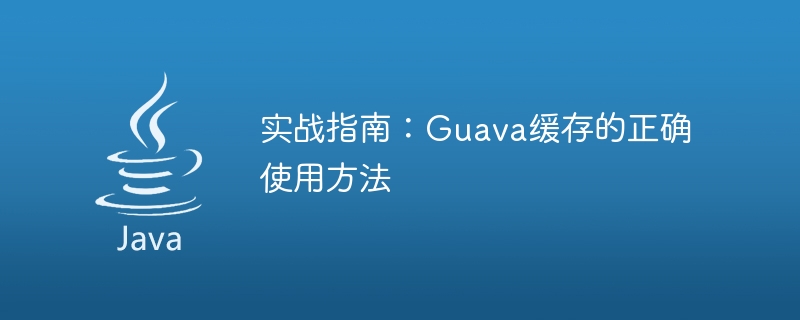Home >Java >javaTutorial >Guava cache usage practice guide
Guava cache usage practice guide
- WBOYWBOYWBOYWBOYWBOYWBOYWBOYWBOYWBOYWBOYWBOYWBOYWBOriginal
- 2024-01-31 21:24:06840browse

The correct way to use Guava cache
Guava cache is a high-performance library for caching Java objects. It provides a variety of caching strategies, and you can choose the appropriate strategy according to your needs to improve the performance of your application.
Basic usage
To use Guava cache, you first need to create a cache instance. You can use the following code to create a cache based on the LRU (least recently used) policy:
Cache<Key, Value> cache = CacheBuilder.newBuilder()
.maximumSize(1000)
.build();where Key and Value are the data types of the cache key and cache value respectively . maximumSizeSpecify the maximum capacity of the cache. When the cache reaches the maximum capacity, the cache items that have not been used for the longest time will be eliminated according to the LRU policy.
Next, you can put the data into the cache. You can use the following code to put the key key and value value into the cache:
cache.put(key, value);
To get the data from the cache, you can use the following code:
Value value = cache.getIfPresent(key);
If the value corresponding to key key exists in the cache, return the value; otherwise, return null.
Caching Strategy
Guava cache provides a variety of caching strategies, and you can choose the appropriate strategy according to your needs to improve application performance. Commonly used caching strategies include:
- LRU (least recently used) strategy: This strategy will eliminate cache items that have not been used for the longest time.
- LFU (Most Recently Used) Strategy: This strategy evicts the least frequently used cache items.
- TTL (time to live) strategy: This strategy will eliminate cache items whose survival time has expired.
- WeakKeys strategy: This strategy uses weak references as cache keys. When the cache key is no longer referenced, the cache item will be automatically eliminated.
- WeakValues strategy: This strategy uses weak references as cache values. When the cache value is no longer referenced, the cache item will be automatically eliminated.
Concurrency Control
Guava cache is thread-safe and can be used in multi-threaded environments. However, if you want to perform concurrent updates to the cache, you need to use a concurrency control mechanism to ensure the correctness of the data.
Guava cache provides two concurrency control mechanisms:
-
Lock mechanism: You can use
Cache.get(Key, Callable)Method to get the cached value. If the value corresponding to keykeydoes not exist in the cache, theCallableobject will be called to calculate the value and the calculation result will be placed in the cache. This approach ensures that only one thread can calculate the cached value in a concurrent environment. -
Atomic update mechanism: You can use the
Cache.asMap().putIfAbsent(Key, Value)method to atomically update the cache value. If the value corresponding to keykeydoes not exist in the cache, the valuevaluewill be placed in the cache; otherwise, no operation will be performed. This approach ensures that only one thread can update the cached value in a concurrent environment.
Best Practices
To improve the performance and reliability of Guava cache, you can follow the following best practices:
- Choose an appropriate caching strategy. According to the actual situation of the application, choosing the most appropriate cache strategy can improve the cache hit rate and reduce cache overhead.
- Avoid caching large objects. Caching large objects takes up a lot of memory and may cause application performance degradation.
- Use concurrency control mechanism. In a multi-threaded environment, the use of concurrency control mechanisms can ensure the correctness and consistency of data.
- Clear cache regularly. Data in the cache may become outdated or no longer needed over time. Cleaning the cache regularly can free up memory space and improve cache performance.
Code Example
The following is a code example using Guava cache:
import com.google.common.cache.Cache;
import com.google.common.cache.CacheBuilder;
public class GuavaCacheExample {
public static void main(String[] args) {
// 创建一个基于LRU策略的缓存
Cache<String, String> cache = CacheBuilder.newBuilder()
.maximumSize(1000)
.build();
// 将数据放入缓存中
cache.put("key1", "value1");
cache.put("key2", "value2");
// 从缓存中获取数据
String value1 = cache.getIfPresent("key1");
String value2 = cache.getIfPresent("key2");
// 打印缓存中的数据
System.out.println("value1: " + value1);
System.out.println("value2: " + value2);
}
}Output result:
value1: value1 value2: value2
The above is the detailed content of Guava cache usage practice guide. For more information, please follow other related articles on the PHP Chinese website!

